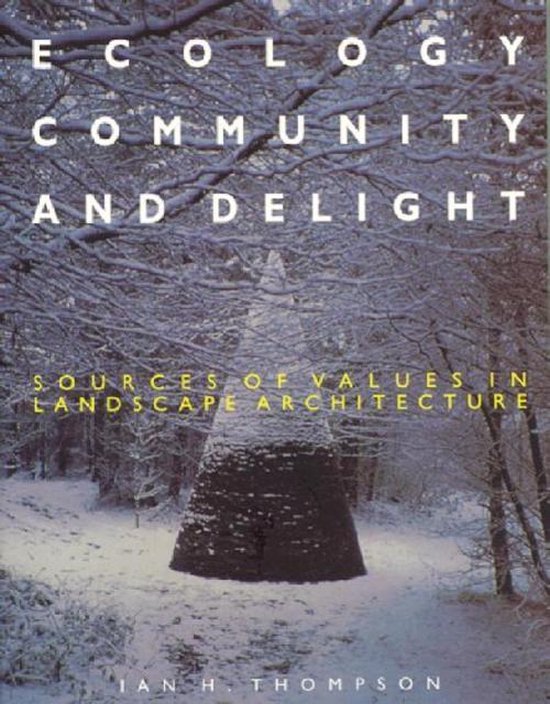
Ecology, Community and Delight (2005) Ian Thompson
Trying to define what landscape architecture is and does, the author (philosopher and landscape architect) finds the three possible attributes (or his battle-cry) – Ecology, Community and Delight. Further, he discusses the aesthetic goals, ethical principles, social values, ecologically derived goals, etc. that landscape architects should pursue. Consequently, he ascribes values to the attributes (Ecology – Environmental values; Community – Social values; Delight – Aesthetic values) and identifies overlapping areas between them. “Tantalisingly there is an area in the centre of this diagram where all three value fields overlap, thus recognising the theoretical possibility of work, which is socially valuable, ecologically sound and aesthetically interesting.” (p.10). Thompson creates a diagram which represents a conceptual analysis and can be considered a framework for assessing landscape architecture work, and as practitioners should seek to increase the positive values of their projects, it appears that improving the values in all three fields – ecological, social and aesthetic – is an obligation.
Initial consecrated theories such as the classical, the beautiful, the sublime and the picturesque landscape made way to theories about the biological, cultural and personal aesthetic preferences in the 20th century, however, the biologically based Savanah Hypothesis was never fully demonstrated. Another approach, the Information processing theory states that landscapes rich in information have four characteristics: complexity, coherence, legibility and mystery. The conclusions of the studies in the matter revealed two prominent categories, the legible park-like scenes and the settings that contain at least one element of mystery in their configuration. Out of these categories, the mystery scenes prevail as the “findings support the contention that human beings are information-hungry creatures, always seeking new situations and new knowledge” (pp.32). Prospect and refuge theories, even if they caused several debates, are approaches that are considered in the design of landscape architecture, often in relation to legibility and mystery theories. This brings the readers to the unavoidable dispute between functional design (a beautiful object is a functional object) and symbolic design (on object caring symbolic meaning can be regarded as a work of art).
In Landscape architecture as artform chapter, after reviewing several art theories, the author suggests some ways in which landscape design might be viewed as art: art as a grand gesture (elevates culture above nature); art as the avant-garde (no significant history of avant-garde landscape designs); art as consummate skill (if the is no symbolic content, the work may be considered technical rather than artistic); art as picture making (mainly consisting of rearranging nature); art as a symbol making (the finished design must have meaning).
In what concerns the social value of landscape architecture we see an increment in public participation in projects. Historically, several methods for involving a community developed: charrette, workshops, planning-for-real, design game, public meetings, steering group, focus group (s), community forum.
“It is a premise of this book that all landscape architects hold a varied set of values drawn from the aesthetic, the social and the ecological spheres. While these values may be mutually supportive, situations may arise when they are in conflict. If an individual designer believes thathe social aspects of his job are very significant and that consultation is important, then that designer’s situation becomes correspondingly more complicated, for now he must not only reconcile his own conflicting values but must give particular weight to the values of others.” (p.133)
The relationship between humans an environment is of concern as we are fast approaching an environmental crisis.
“However, the proliferation of ideas within environmental ethics can seem bewildering and prolix. To progress we need a typology of the principal strands. There are two useful ways of approaching this daunting area. One is to consider the varieties of ethical theory in terms of the kinds of objects which they consider to have intrinsic worth, and, as such, to be worthy of moral consideration. Here there are two broad divisions, the anthropocentric and the nonanthropocentric, each of which may be subdivided. Anthropocentric theories include both egocentric and homocentric varieties, while nonanthropocentric theories can be classified as either biocentric or ecocentric. The second approach, […] emerges from different positions within environmental ethics. These typologies are offered as useful conceptual tools, but it would be a mistake to regard any of the categories as hard-edged or mutually exclusive. There are infinite shades of environmental thought.”
The Anglo-American landscape architectural theory considers three eras in connection with environmental perspectives: Pre-1960 use and beauty; 1960-80 the era of environmental awareness; Post 1980 challenges to complacency and describes them in chapter 8. Expressing his opinion about sustainability, he stresses that sustainability becomes a guiding principle in landscape architecture, it will have both ethical and aesthetical consequences as:
“From landscape architects/ planners it requires not just the avoidance of development on ecologically sensitive lands, but also new visions of the landscape informed by the emerging discipline of landscape ecology.” (p.190)
Ioana Mădălina Moldovan
Universitatea Tehnică din Cluj-Napoca
Thompson, H. Ian. Ecology, Community and Delight. Sources of Value in Landscape Architecture. Taylor & Francis Group: E & FN Spon, 2005.
